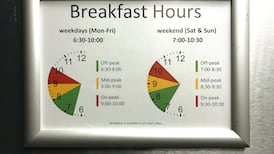Get ready for the post-lockdown boom. Much of the economy is already growing strongly and the reopening sectors will now bounce, even if they will not return to their pre-pandemic position. There are signs of labour shortages and pressure on wages in some sectors. Tax revenues will finish the year ahead of target. Even the aviation sector is showing signs of life.
It is difficult to judge how much of what is going on is due to a bounceback from pandemic closures and how much is long-term sustainable growth. But many of the sectors which operated through the pandemic continue to do well. Recruiters report job shortages and wage pressures in sectors such as tech, parts of the financial sector and newly challenged HR departments.
Some of this is due to a lack of inward migration during the pandemic. But underlying growth looks strong too in the multinational-dominated sectors. And there are signs of recovery in the domestic economy too as restrictions ease – with more to come. The future of sectors reliant on tourism, hospitality and indoor performance remains challenging and hard to predict. Many former employees will not get their jobs back. But for now the trajectory, post-lockdown, is upwards. Consumer spending is now rising strongly as restrictions lift – as confirmed by the latest economic data.
This is, of course, encouraging. The pandemic is not over, but the economy has come through so far better than anyone would have expected had we known large parts of the economy were going to remain shut for so long. The outlook for the two budget Ministers – Paschal Donohoe and Michael McGrath – is for the public finance numbers for this year to come in ahead of target. The problem for them, of course, is that this will only increase pressure to carry on spending – or carry on increasing spending.
Government expenditure soared during the pandemic as emergency supports were put in place, funded by massive borrowings. It was the right thing to do. But now, while these supports are being withdrawn, some of the cash is being redirected to spending increases in the years ahead, both in investment and day-to-day expenditure. The budget forecasts have already been redrawn to allow for borrowing to remain higher than originally indicated in the next few years to fund this.
Mini-boom
The mini-boom to come, as the economy reopens, will boost the exchequer. All the political focus now is on spending – on housing, on post-pandemic supports, on health and on a massive investment programme planned for the next few years, which will also have a heavy bill from climate change.
While the short-term outlook is for an economic bounce, beyond that decisions will be needed. The spending commitments are building up. Economic growth will, let’s hope, pay for a lot of this in the years ahead. Along with the expectation that rock-bottom interest rates will remain, this has led to political debate skirting how all this will be paid for.
And there are threats, too. One obvious question surrounds corporate tax revenues, where a major international reform programme is currently under discussion. A decline in revenue here – responsible for one euro in every five of tax collected – is already built into the budget forecasts for the next few years. But we really don’t know where this will land or what it will mean for our public finances.
The other big question is European Central Bank (ECB) policy. One of the big debates in economics internationally is how central banks should behave in a post-Covid world. Should they continue to support government spending when needed, or return to a more traditional role of prioritising inflation? And inflation is now in the headlines, with euro-zone prices rising at 3 per cent over the past year, the fastest increase in a decade. The story is that this is temporary – due to rising energy prices largely – and will wash out of the system over the next year. But we just don't know – and consumer spending and wage trends will be vital.
On both sides of the Atlantic, central banks are discussing how and when to start winding down massive programmes to buy government bonds, which have allowed countries to borrow at zero or sometimes negative interest rates. Around the ECB table, a German-led group is arguing for a quick wind-down so as not to take risks with inflation becoming embedded. ECB policy is likely to remain supportive next year, but beyond that we just don’t know.
Stabilisers
For now investors can lend money to countries, safe in the knowledge that the central bank will buy the loan if they want to offload it. Once these stabilisers are removed, investors will cast a colder eye, based on the sustainability of public finances in different countries. The premium charged to riskier countries will rise – possibly quite sharply. That is why Ireland wants to keep borrowing at a similar level to other euro zone countries – so as not to appear out of line and be able to continue to borrow at low interest rates. It will be a delicate balance.
This is what will start to drive decisions in Ireland before too long. Central Bank governor Gabriel Makhlouf was the latest to point out this week that longer-term, permanent spending increases need to be funded by new taxes. Or spending can be cut elsewhere, though that doesn't seem likely. This is not austerity, it is just common sense. Funding the massive commitments which now lie ahead is a debate which was postponed during the pandemic. But it can't be put on the long finger forever.
The short-term economic outlook is encouraging– in the circumstances – and we are heading for a rebound bounce. It is as good as we could expect, given what we have lived through. But big decisions lie ahead which will cause furious debate both within the Government and across politics.









